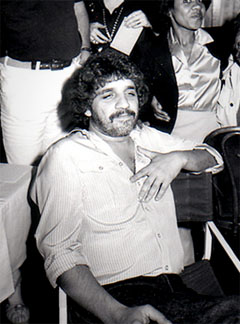|
| Magriel's NYT Columns |

Michael Maxakuli The first annual Bill Eisenberg Cup was held last weekend at the Cavendish West Club in Los Angeles. Bill Eisenberg, a top West Coast player, was 1975 world champion of backgammon. Nevertheless, he is probably better known for skill in another game, bridge; four times he has been a member of a world championship team.
The tournament, which drew a strong field of 128 players, was won by Gaby Horowitz, who teaches backgammon in the Los Angeles area. He triumphed over Michael Maxakuli, president of the Las Vegas Backgammon Club, in the finals. Chuck Papazian of San Francisco defeated Bill Bartholomay of Chicago to win the consolation flight.
The diagrammed position occurred in the 25-point finals with Maxakuli (Black) trailing Horowitz (White) 24 to 16. With Horowitz only one point away from victory, the Crawford Rule, preventing doubling, was in effect.
|
24
MATCH TO 25 16 |
| Black to play 4-2. |
Instead of playing safe, Black (Maxakuli) made a better play, 6/2, 15/13. This play leaves Black with a single man on his 15-point, exposed to a direct shot. Black had good reason to relinquish the 15-point immediately. To see why, it is necessary to look ahead a few rolls and anticipate the game’s likely development.
|
|
|
By breaking his 15-point immediately, Black takes his chances before White is properly prepared. White’s home board is now extremely weak. If White hits, his game will be disorganized and highly vulnerable. Indeed, White cannot afford a tactical confrontation until he first strengthens his position.
Maxakuli’s steep play helped him win this game (in fact, a gammon), and so keep alive his hopes of winning the match. He scored two more points next game, but then his comeback attempt ended. The final match score was Horowitz 25 to Maxakuli’s 20.
Rollout
 Tom Keith 2013 |
|
Match to 25 White 24, Black 16 Crawford Black rolls 4-2 1296 games with VR Checker play: 2-ply Cube play: 3-ply Red |
| 4-2: | Game | G | BG | Equity | ||||
| 1 | 15/13, 6/2 |
W L |
.7400 .2600 |
.3511 .0358 |
.0087 .0012 | +0.5324 |

| (b) |
| 2 | 6/4, 6/2 |
W L |
.7090 .2910 |
.3309 .0467 |
.0077 .0021 | +0.4668 | (0.0656) | (a) |

|
|

